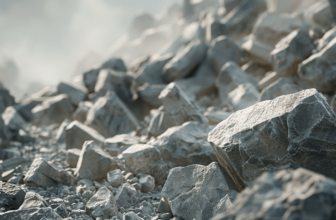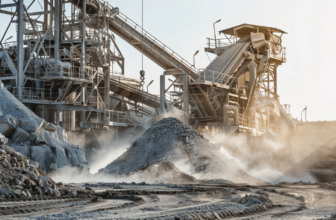From our homes and roads to our landscapes and farms, crushed stone is essential to building and nurturing the world around us. But have you ever wondered how large, barren rocks are transformed into versatile, crushed stone that fits our needs? Understanding this process involves learning about the specialized equipment that makes it possible.
This article aims to uncover the world of rock-crushing machinery and the intricate process that results in fine crushed stone. We will dive into the importance of crushed stone in various industries, explore different types of rock-crushing equipment, and explain the process of creating the crushed stone. We will also help you navigate the factors to consider when choosing rock-crushing equipment. So whether you’re interested in how to crush stone or you want to understand the steps that lead to finely crushed stone production, you’re about to embark on a revealing journey. Let’s begin.
Importance of Crushed Stone in Various Industries
Construction Industry
In the construction industry, crushed stone is a critical resource for multiple purposes. From laying a solid foundation for roads and buildings to forming part of the concrete and asphalt mix, the use of crushed stone is indispensable. With the aid of a stone crush machine, large rocks are transformed into smaller, more manageable materials for construction projects.
Landscaping Industry
The landscaping industry also relies heavily on crushed stone. It is commonly used to improve the aesthetic appeal of residential and commercial properties. Crushed stone can be used for drainage purposes, as a ground cover, to create pathways, or in decorative garden edges. Its versatility, texture, and colors allow for significant creative flexibility in design.
Agricultural Industry
In agriculture, crushed stone, often called “aglime,” can neutralize acidic soils, improving the pH level and creating a more hospitable environment for crops. This specific type of crushed stone is typically produced using a stone crush machine designed for producing finer particles.
Understanding the Types of Rock Crushing Equipment
Jaw Crushers
Jaw crushers are the most common type of rock-crushing equipment. Using compressive force, these machines break down large rocks into smaller pieces. The crushed stones are typically angular and more suited for construction and road building.
Impact Crushers
Impact crushers leverage the force of impact to crush rocks. Rocks are thrown against metal plates, known as impact plates, to break them down into smaller pieces. The crushed material is cubical, making it ideal for projects requiring a particular shape, such as road construction or landscaping.
Cone Crushers
Cone crushers crush rocks between a rotating piece of steel and a stationary piece. The crushed stone is typically uniform in size and less flaky, making it perfect for many construction projects. It’s particularly effective in creating fine crushed stone.
Gyratory Crushers
Gyratory crushers are similar to jaw crushers but offer the advantage of providing a more consistent and less flaky output. They are usually used for primary crushing, preparing the rocks for secondary and tertiary crushing processes.
Process of Creating Fine Crushed Stone
Primary Crushing
Primary crushing is the first stage, which reduces the size of large rocks using equipment such as jaw or gyratory crushers. This process prepares the rocks for further crushing and helps in easier handling.
Secondary Crushing
In secondary crushing, smaller crushers like cone crushers or impact crushers are used to further reduce the size of the rocks. The output is smaller, more manageable stones.
Tertiary Crushing
Tertiary crushing aims to produce even smaller rocks, often involving cone crushers or other types of impact crushers. This process creates the smaller, fine crushed stone used in many applications, such as construction or agriculture.
Quaternary Crushing
In some operations, a further stage known as quaternary crushing is undertaken to produce ultra-fine crushed stone. This stage uses specialized equipment and can create particles as small as sand.
Factors to Consider When Choosing Rock Crushing Equipment
Type of Rock
The nature of the rock intended for crushing significantly influences the selection of the crushing equipment. Rocks exhibit a broad spectrum of characteristics, from hardness and abrasiveness to size and consistency. These characteristics directly impact the effectiveness and wear-and-tear of the crushing equipment.
For example, soft rocks, such as limestone, sandstone, and even some hard rock, like granite, can often be effectively processed by less powerful machines, such as jaw crushers. On the other hand, extremely hard or abrasive rocks, like quartzite or basalt, typically require more robust crushers like cone crushers for efficient processing.
Desired Size of Final Product
The size of the final product is a decisive factor in choosing the appropriate rock-crushing equipment. Different crushers produce various sizes and shapes of crushed stone. For example, you might opt for a jaw crusher if you need large pieces for a road base. On the contrary, if the goal is to produce fine crushed stone for something like a concrete mix or agricultural use, you’ll likely need a cone crusher or an impact crusher for tertiary crushing. Defining the desired size and use of the final product beforehand will guide the selection of the most suitable rock-crushing machine.
Production Capacity Requirements
Production capacity requirements are another essential factor when choosing rock-crushing equipment. Your operational goals and the volume of rocks to be processed will determine the size and power of the machine you need. Smaller operations, or those with infrequent crushing needs, may find that compact or mobile crushers are sufficient.
In contrast, large-scale operations or commercial quarries processing large volumes of rocks daily will benefit from larger, stationary crushers with high capacity. It’s also important to consider scalability — if your operation is expected to grow, investing in a machine that can handle increased capacity might be wise. This proactive step can save time, money, and resources in the long run.
Budget Considerations
Finally, your budget plays a significant role in your choice of equipment. High-capacity crushers often come with a higher price tag, and maintenance costs can also add up over time. It’s crucial to find a balance between the cost of the machine and its performance to ensure cost-effectiveness.
From the construction of roads to the improvement of crop-growing conditions, the applications for crushed stone are incredibly diverse. Understanding how to crush stone using the right equipment for the right purpose ensures the production of high-quality crushed stone, ready for its next application. Whether you’re producing crush and run stone or fine crushed stone, the choice of equipment plays a significant role in your output’s quality and consistency.







